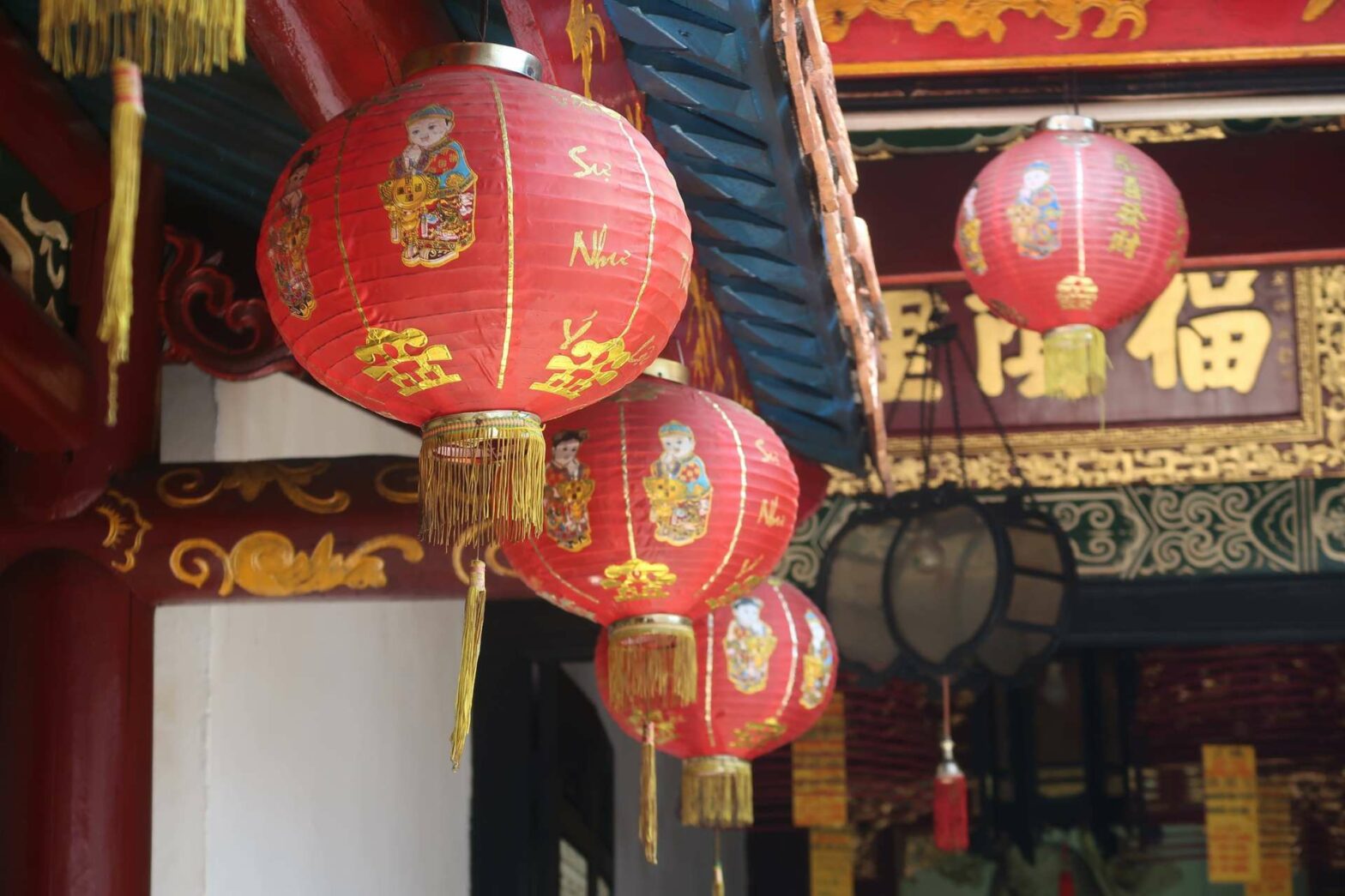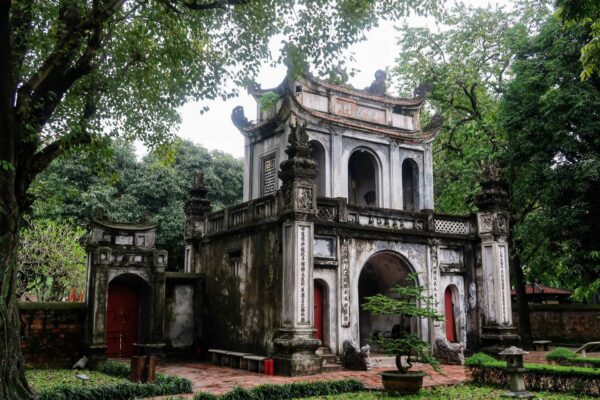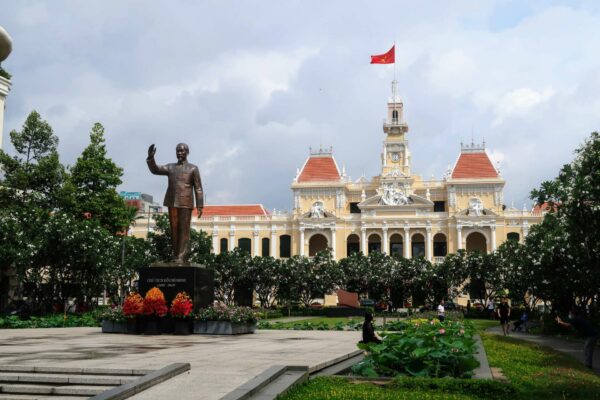By Vicky · Published Dec. 17th, 2023
When you buy through links highlighted with an asterisk (*) on this site, we may earn a small affiliate commission at no cost to you.
Explore charming Hoi An on this free self-guided walking tour, which leads you through the narrow streets to ancient temples and more. Hoi An is a UNESCO World Heritage Site known for its well-preserved architecture and its significance as a trading port from the 15th to the 19th centuries walking around today feels like you’ve gone back in time.
Page Contents:
How to get to Hoi An
Hoi An is a town in central Vietnam, which unfortunately doesn’t have its own train station. The nearest train station is in Da Nang.
Hoi An from Da Nang
Hoi is a 45-minute drive south of Da Nang. To get from Da Nang to Hoi An, you can either take a taxi or a bus. To book taxis, buses or trains to Da Nang, it’s easiest to use 12GoAsia*. You can see several options with prices and for trains, you can see which still have space and get ticket confirmation immediately after booking.
Hoi An from Hue
Hoi An is about 3 hours drive (120 km) south of Hue. The most popular way to travel between these two historic towns is on a tour over the scenic Hai Van Pass*.
Hoi An Walking Route Map
Get the route by downloading the .gpx or .kml file below. For navigation with Maps.me on your mobile phone, simply download the .kml file and open to add it to the Maps.me bookmarks.
Tips for visiting Hoi An
- 22 sights in Hoi An require a ticket – you can buy strips of 5 for 120,000VND (about $5) from the tourist information just next to the bridge. The top five sights are mentioned below.
- Early mornings or late afternoons are a good time to enjoy this walk to avoid both the heat of the day and the crowds.
- If you visit any of the temples, you should cover your shoulders and knees.
- Discover the top tours in Hoi An*
- Exploring Hoi An by bicycle is the best way to explore – try and stay at a hotel that offers free bicycle rental.
- Cycling to the beach or around the countryside is a great way to explore further.
- Opt for an evening lantern-making workshop* to experience Hoi An’s famous lantern tradition firsthand.
- After visiting Hoi An, why not head to the Imperial City of Hue! Or check out our Vietnam Page to explore further.
Top Sights within Hoi An
On this walking tour you’ll see the main sites and attractions of Hoi An. Those with an asterisk are part of the 22 ticketed sights, the others are free. This is a free, self-guided walking tour of Hoi An. If instead you’re interested in a guided tour, check out the Hidden Gems of Old Hoi An Tour*, or if you’re into food, check out a walking tour to sample the local specialties!*
- Japanese Covered Bridge*
- Thu Bon River
- Phung Hung Ancient House*
- Cam Pho Temple*
- Confucius Temple
- Pháp Bảo Temple
- Ba Mu Temple
- Tran Family Chapel*
- Đình Ông Voi Village Hall
- Trung Hoa Assembly Hall*
- Fukian Assembly Hall*
- Central Market
- Hoi An Traditional Art Performance House*
- Ancient House of Tan Ky*
- Cantonese Assembly Hall*
Hoi An Walking Tour Route
This self-guided walking tour of Hoi An starts at the Japanese Covered Bridge in the centre of town. Several of the attractions on the route require tickets. You can purchase sets of 5 tickets for roughly 120,000VND (about $5) from the tourist information just next to the bridge.
There are more than 5 attractions, but the top five are the Japanese Covered Bridge itself, the Fukian Assembly Hall, the Cantonese Assembly Hall, the Hoi An Traditional Art Performance House and one of the Ancient Houses (Phung Hung or Tan Ky).
Directions: After buying tickets, head onto the bridge.
1. Japanese Covered Bridge*
The Japanese Covered Bridge* is an iconic 16th-century bridge that connects the Japanese and Chinese quarters. The bridge is now one of the symbols of Hoi An and the centre of the Ancient Town. It’s a unique architectural construction, combining Japanese and Vietnamese design elements. Its most distinctive feature is the roofed structure that spans across a small body of water, connecting two sides of the town.
Don’t miss the sculptures of a monkey and dog at opposite ends of the bridge, signifying the years the bridge was started and finished (1593 and 1595). Inside the bridge, there’s a small temple dedicated to Taoist deities, where locals and visitors often offer prayers for luck and prosperity.
Directions: From the Japanese Bridge, head to the waterfront and across the main bridge to An Hoi island. Turn left on the other side to walk along the riverbank.
2. Thu Bon River
Stroll along the banks of the Thu Bon River to enjoy the views, and potentially get a little breeze from the water. You’ll see palm trees, fishmermen, and many colourful painted boats. You can also see the cute buildings and roofs of the houses on the other side.
Directions: Head right across the next bridge, then right on the other side still by the river. Turn right at the road then take the first left along a small street. At the next road, turn right along the pleasant road back towards the bridge.
3. Phung Hung Ancient House*
Phung Hung Ancient House is a traditional Vietnamese merchant’s house that has been preserved to showcase the architectural and cultural heritage of the region. The house is a typical example of a 19th-century Hoi An merchant’s residence, reflecting the blend of different architectural styles, including Chinese, Japanese, and Vietnamese influences.
On a visit, you can explore the various rooms within the house, gaining insights into the daily life and activities of the merchant families who once lived there. Additionally, today the house serves as a venue for cultural events and activities.
Directions: Return the way you came, and continue along the street. You’ll see the temple gates on your right.
4. Cam Pho Temple*
Cam Pho Temple is dedicated to Thien Hau, the goddess of the sea and protector of sailors and fishermen. Thien Hau, also known as Mazu in Chinese culture, is revered in many coastal regions of East Asia. Hoi An has been home to fishermen and ocean-going traders for a long time. Still today people gather at Cam Pho Temple to pay homage to Thien Hau and seek blessings for safe voyages, prosperity, and good fortune.
Directions: Head along the street to reach the main road, with cars and motorbikes. Turn right and soon you’ll see the Confucius Temple on your left, opposite the memorial column.
5. Confucius Temple
The Confucius Temple, also known as Miếu Thờ Khổng Tử, is right on the edge of Hoi An Ancient Town. This means not many people visit, but I thought it was one of the most impressive sights in Hoi An. If the main gate is closed, there’s a smaller gate nearby. There’s a fun bridge across a moat, after which you reach a spirit wall with a mythical creature guarding the temple behind. Here and all around the temple there are sculptures covered in colourful ceramic tiles. It’s definitely worth an exploration.
Just opposite the Confucius Temple is Quang Nam Memorial, a tall pink column by a pond full of lotus flowers.
Directions: Return back towards the previous temple, but now take a left before reaching it. Continue along this straight street until the next intersection. Pháp Bảo Temple is on your left.
6. Pháp Bảo Temple
Pháp Bảo Temple, also known as Phac Hat Pagoda, is a Buddhist temple with lovely gardens often full of blooming flowers. It’s free to enter, and you have to take your shoes off to enter the temple. You’re also requested to dress appropriately, i.e. covered shoulders.
Directions: Head down the street on the opposite side of the intersection for a short distance, and the next temple is on your left.
7. Ba Mu Temple
Ba Mu Temple is not a temple in the traditional sense, but rather just a very ornate and highly decorated temple gate. There’s a lovely lily pond in front of it, which makes it very photogenic both during the day and at night.
Directions: Head back to the intersection and continue along the straight street to the next main junction. The Tran Family Chapel is on your left.
8. Tran Family Chapel*
The Tran Family Chapel is a historic house and museum offering insights into the lifestyle of the prosperous Tran Family. There’s beautiful woodwork, intricate carvings, and decorative elements that reflect the cultural tastes of the time.
Directions: Walk down the street opposite the chapel, and you’ll see the next stop on your left.
9. Đình Ông Voi Village Hall
Đình Ông Voi is a historic village hall and temple, notable for the two large stone elephants outside and the intricate spirit screen. It’s dedicated to Quan Cong, the Elephant God, who is regarded as a symbol of loyalty, justice, and integrity.
Directions: Continue down the street and left at the second crossroads along the pedestrianised street. You’ll soon see the blue gates of the Trung Hoa Assembly Hall on your left.
10. Trung Hoa Assembly Hall*
The Trung Hoa Assembly Hall has a fusion of Chinese and Vietnamese styles, featuring elaborate decorations, intricate woodwork, sculptures, and vibrant colors.
Directions: The next assembly hall is just a short distance further down the street.
11. Fukian Assembly Hall*
The Fukian Assembly Hall is one of the most impressive Assembly Halls in Hoi An, dating from 1697. Inside you’ll see several animal statues, each representing some quality of life such as wisdom, long life, or noble status. There are several detailed mosaics, but perhaps most impressive is the ceremonial gate. It takes about 5-10 minutes to walk around and is definitely worth stopping by.
Directions: Turn right along the next street by the market, then right again when you reach the river.
From here you can take a detour to Bánh Mì Phượng, a famous restaurant where you can grab a banh mi sandwich, a local specialty. It’s often busy and there can be long lines, but they move quickly. If you want to learn more about cooking Vietnamese dishes, try a cooking class!*
12. Central Market
In the Central Market you can savour the local flavors at the market’s food stalls offering delicious Vietnamese cuisine. A bustling market selling almost everything, from fresh produce to souvenirs and tailored silk outfits. It’s a great spot to interact with the local vendors, practice bargaining for goods, and experience the vibrant energy of the market.
Directions: Continue along the street by the river and the next stop is on your right.
13. Hoi An Traditional Art Performance House*
Visit the Hoi An Traditional Art Performance House to see traditional Vietnamese art shows, including music and dance. There’s free seating so arrive early if you want a good seat. Performances occur at 10:15 and 3:15 and last roughly 30 minutes.
Directions: Take the third street on your right, then turn left and the ancient house is on your left.
14. Ancient House of Tan Ky*
The Ancient House of Tan Ky is an old merchant’s house full of antiques, set around a lovely courtyard. It dates from 1741 and was specifically designed to withstand flooding which was common at the time. The levels of previous floods have been recorded, and sometimes the water reached very high! You can buy some of the antiques and souvenirs on display inside.
Directions: At the next junction turn right and you’ll see the impressive gates of the Cantonese Assembly Hall.
15. Cantonese Assembly Hall*
The Cantonese Assembly Hall was built in the late 18th century. The assembly hall served as a communal gathering place for social, cultural, and religious activities within the Cantonese community. Behind the elaborate gate there’s a courtyard and the main hall. Inside are alters dedicated to various gods such as Thien Hau, the goddess of the sea. There’s a large garden at the back with a fountain and dragon statue where you relax, it’s definitely worth a visit.
Directions: You’re now back by the Japanese Covered Bridge and the end of the Hoi An Self-Guided Walking Tour. Continue reading to discover the best evening activities and day trips from Hoi An.
Top Evening Activities in Hoi An
The evening is a great time in Hoi An, when temperatures drop and the Ancient Town comes alive with people and lanterns. The top five evening activities to enjoy in Hoi An are below:
1. Attend a Lantern Making Class
Learning how to make the lovely lanterns that Hoi An is famous for is a great way to spend an evening. In this lantern-making class*, you learn how to make your very own silk lantern and can then take it away with you.
2. Watch the Bamboo Circus
The Teh Dar Vietnamese Bamboo Circus at Hoi An Lune Center* is the main evening show in Hoi An, where traditional performances showcase Vietnamese music and dance. There’s also acrobatics and it makes for a really great evening. The show lasts one hour so there’s still time afterward to visit the night market.
3. Visit Hoi An Night Market
At Hoi An’s Night Market, explore stalls selling handmade crafts, souvenirs, and local street food. It’s right next to the river on An Hoi Island, opposite the Japanese Bridge. Everywhere is full of lanterns and it’s very atmospheric. To have the most immersive experience, you can go on a tour of the night market*, which includes a fun boat ride.
4. Take a Lantern-Lit Evening Boat Ride
Take a boat ride along the river* or join a lantern-lit evening cruise to cool down and relax after a day wandering around Hoi An. It’s a fun activity and the boats start just next to the night market, near the Japanese Bridge.
5. Go on an Evening Walking Food Tour
Check out the best street food and restaurant spots on a food walking tour*. You’ll also discover the top hidden gems of Hoi An at night!
Best Day Trips from Hoi An
1. My Son Sanctuary
- Distance from Hoi An: 40 km west.
- Why Visit: UNESCO World Heritage Site with impressive ancient Hindu temples and ruins dating back to the Champa Kingdom. Definitely one of the top trips to make from Hoi An, and not to be missed when touring Vietnam.
- Top Tour: Small group early morning My Son Sanctuary tour*
2. Ba Na Hills & Golden Hand Bridge
- Distance from Hoi An: 50 km northwest.
- Why Visit: Walk over the famous Golden Bridge on the Huge Hand of Budda and experience great views from the hills.
- Top Tour: Hoi An/ Da Nang – Ba Na Hills – Golden Bridge Deluxe Small group*
3. Hue City
- Distance from Hoi An: 120 km north.
- Why Visit: Former imperial capital with the Imperial City, royal tombs, Perfume River, and historical sites showcasing Vietnam’s rich history.
- Top Tour: Small Group Hue City Tour From Hoi An and Da Nang*
4. Tra Que Vegetable Village & An Bang Beach
- Distance from Hoi An: Close to Hoi An, within biking distance.
- Why Visit: Experience local farming life, enjoy cooking classes using fresh produce* and relax on the nearby beach.
- Top Tour: Hoi An to An Bang Beach Cycle
5. Cycle through Cam Kim Island
- Distance from Hoi An: Close to Hoi An, within biking distance.
- Why Visit: See rice fields, coconut groves and much more on an idyllic island just next to Hoi An.
- Top Tour: Hoi An Cam Kim Cycling (self-guided) or Afternoon Countryside Bike Tour from Hoi An* (guided).
Moving on from Hoi An
If you’re heading north, why not visit the Imperial City of Hue or the spectacular countryside of Ninh Binh. You can reach Hue or Ninh Binh on the train from Da Nang. The overnight trains are relatively comfortable, save time and also save one night’s accommodation. It’s easiest to book on 12GoAsia* since you have to have a Vietnamese credit card to book on the official website.
Alternatively, it’s popular to travel to Hue via a tour over the scenic Hai Van Pass*, which takes at least 3 hours.
From Hoi An, if you’re heading south then taking a bus to Da Nang and then a train is a popular option.
For more ideas of where to go next, check out our Vietnam Guide.
Useful things for a holiday in Vietnam
- Travel Insurance: we use SafetyWing*, it’s simple to buy online and they have a downloadable letter proving you have travel insurance which includes Covid-related issues
- Travel Debit Card: we have Wise Cards* which allow you to cheaply convert most currencies into Vietnamese Dong. You can then pay by card within the country for no extra fees, or withdraw cash from an ATM.
- We booked train travel in Vietnam through 12GoAsia*. They charge a few extra dollars in commission, but to book directly on the official website you must have a Vietnamese credit card.
FAQS: Hoi An Self-Guided Walking Tour
Hoi An is one of the best-preserved towns in the whole of Vietnam. It can be a little touristy, but the cute streets and highly decorated temples make it definitely worth a visit.
I’d recommend staying in Hoi An since it becomes very atmospheric in the evening with the night market and lanterns decorating every street. It’s a great time to walk around Hoi An, and it would be a shame to leave earlier in the day, so staying in Hoi An is the best option.
There’s a lot to see in Hoi An, and it makes a great base for several day trips, so spending at least 2-3 days minimum in Hoi An is recommended. If you want to relax more, attend several classes such as cooking or lantern making, or if you want to base yourself in Hoi An for day trips, you could easily spend a week here.








